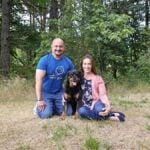


Home » Paula Webber | Van Isle Appenzellers

Paula Webber
1. I live on Vancouver Island, British Columbia. I grew up with dogs all through my life. My dad had hunting dogs; Labradors and Chesapeake Bay Retrievers. I suppose my love of dogs came through my father. He was the most empathetic person when it came to animals. He often took on the misfits, loved them, trained them, treated them as family members. I had numerous dogs as an adult, mostly mixed breeds. My first purebred dog was a Bernese Mountain dog. Then, in 2002, I acquired my first Appenzeller Sennenhund, and my second in 2014, a beautiful male that I began breeding in 2018. He has sired six beautiful litters in Canada and the US. I don’t have a registered kennel name. I have one stud dog, and use Van Isle Appenzellers, but as yet have not registered the name with CKC.
2. Appenzellers, overall, are a healthy breed but can be susceptible to hip and elbow dysplasia, and patellar luxation, not unlike many other medium to large breeds; which is why testing for these conditions is required prior to any planned breeding. My first Appenzeller lived close to 16 years.
3. As the owner of a rare breed, the challenge is education about the breed, not just for judges but for dog fanciers in general. I began showing my male in 2014, and at that time he was the only Appenzeller being shown in North America. Most judges had never seen an Appenzeller, unless they had foreign judging experience. In addition, there are limited opportunities to show that make it affordable to travel cross border, being an exhibitor from Canada, until 2023 when the breed became listed with CKC. AKC FSS shows are few and far between on the West Coast. For many years, my dog(s) were the only Appenzellers competing in any dog sports and Conformation. We are beginning to see a few more in the show ring, and in performance/companion events. That said, the sport is not for everyone.
4. The biggest challenge for Appenzellers is the low number of dogs showing. Currently, there is only one Appenzeller with CMs. Until such time as more dogs enter Open Shows, it will take a very long time to achieve full recognition. In addition, there are few Appenzeller breeders in North America, thus a small gene pool. With the new CDC Dog Import rules, the import of dogs to the US has presented major challenges for breeders.
5. Social media can be very useful in terms of education, news, and providing information. As with anything else, dog fanciers need to scrutinize the social media forums. I’m only interested in those that benefit the fancy.
6. My goal, since I acquired my first Appenzeller over 20 years ago, is to raise healthy dogs, love them, train them, and showcase their incredible versatility and beauty. For me, it’s not about the wins, which are always a bonus, but more so that judges, other exhibitors, and dog fanciers can learn about this magnificent breed.
7. In terms of my own rare breed, and the efforts I’ve put into my dogs, sharing my knowledge of the breed, a positive change is that more judges have had the opportunity to put their hands on an Appenzeller and see good examples of the breed.